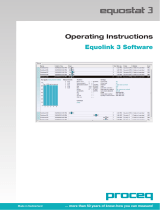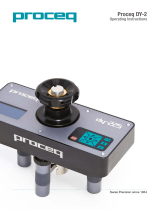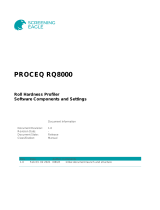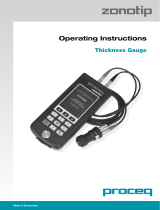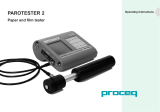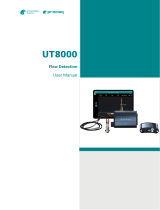
Resipod Remote Control Interface
Documentation
This document describes the Resipod remote control interface
Key Words: Resipod, Communication, Documentation
Document Revision: 1
Revision Date: 19-January-2012
Document State: released
David Corbett david.corbett@proceq.com
Company: Proceq SA
Ringstrasse 2
CH-8603 Schwerzenbach
Switzerland
Classification: for internal use and customers who bought a Resipod package

Revision History
Rev
Date
Author, Comments
01
19-January-2012
David Corbett
Table of Contents
Resipod Remote Control Interface .......................................................................................... 1
Documentation ......................................................................................................................... 1
1. Introduction .......................................................................................................................... 3
1.1 Scope / intended use ....................................................................................................................... 3
1.2 Boundary conditions ........................................................................................................................ 3
1.3 Abbreviations ................................................................................................................................... 3
2. Overview ............................................................................................................................... 4
2.1 Purpose ............................................................................................................................................ 4
2.2 Notation ............................................................................................................................................ 4
2.3 Requirements, prerequisites, limitations .......................................................................................... 4
2.4 Suggestions, bugs, improvements................................................................................................... 4
3. Serial interface ...................................................................................................................... 5
3.1 Virtual COM port driver .................................................................................................................... 5
3.2 Serial Interface parameters ............................................................................................................. 5
3.3 Detect Resipod device ..................................................................................................................... 5
4. Remote commands description .......................................................................................... 6
4.1 Request device data ........................................................................................................................ 6
4.2 Measurement command .................................................................................................................. 6

1. Introduction
1.1 Scope / intended use
This document describes the Resipod remote control interface. It consists of a set of binary
commands which allow the user to extract data from the Resipod device and to collect
measurement data using a remote PC.
The target audience is software engineers and Proceq customers who want to embed
Resipod remote functionality into their own PC applications.
1.2 Boundary conditions
Software versions described in this document:
Resipod: Firmware Version: 1.0.4
General: See [2.3 Requirements, prerequisites]
1.3 Abbreviations
Term
Description
HW
Hardware
SW
Software
USB
Universal serial bus
UART
Universal Asynchronous Receiver Transmitter
TBD
To Be Defined

2. Overview
2.1 Purpose
The purpose of this document is to describe all necessary interface facts to enable
customers to use the Resipod device in a most flexible way according to their needs. A
possible application is:
Controlling Resipod and collecting measurement data from Resipod using own
software and databases to be further processed or stored without the need of the
Resipod Link software and the overhead of unneeded manual work.
2.2 Notation
The different functions can be started through remote commands described later in this
document. The description of the individual commands is based on the following rules:
Each command consists of a defined number of bytes. These bytes are always described in
hexadecimal syntax (e.g. 0x12 = 18 decimal). Or as a combination of hexadecimal and ASCII
syntax.
2.3 Requirements, prerequisites, limitations
To avoid problems during remote connection please take care of the following:
Make sure the Resipod is powered on and connected to the PC
Do not disconnect the Resipod while communication with the PC is active
Do not try to start/stop measurements locally by pressing any Resipod button while
measurements are being triggered remotely from a PC.
2.4 Suggestions, bugs, improvements
We hope that with this solution we can fulfill most customer needs regarding the matter of
automation and remote control of Resipod.
Should there be any bugs, missing commands, questions and other suggestions regarding
this add-on, please feel free to write an email to:
software@proceq.com
We appreciate your feedback and we will gather any incoming information and try to help
whenever possible.

3. Serial interface
3.1 Virtual COM port driver
The Resipod offers a USB UART interface by which it can be remotely controlled from a PC.
i.e. physically, the device appears like a normal USB device, but internally the Resipod uses
a UART, which is an asynchronous, serial interface (similar to RS232). A so called USB
bridge device on the Resipod makes the conversion from UART to USB signals and vice
versa.
On the PC side it is necessary to install a virtual COM port driver, which causes the Resipod
(USB) device to appear as an additional COM port available to the PC. This allows
application software running on the PC to access the Resipod Lab in the same way as it
would access a standard COM port.
To install the virtual COM port driver you can either:
Get and install Proceq’s Resipod Link software. The virtual COM port driver is
installed automatically.
or:
Get the virtual COM port driver setup program from FTDI’s home page
(http://www.ftdichip.com/Drivers/VCP.htm)
Provided that the PC has an active internet connection, some newer versions of the
Windows operating system (XP, Vista and 7) automatically get and install the needed driver
when the USB device is connected.
3.2 Serial Interface parameters
To be able to communicate to the Resipod device, the following serial interface parameters
must be set:
19200 baud
8 data bit
1 stop bit
No parity
3.3 Detect Resipod device
When the Resipod device is connected to a PC, the Windows operating system automatically
assigns a COM port number. To find the correct COM port from within an application
program, it is best to scan the COM ports starting at COM1, COM2, and so on. By sending
the Get_Instrument_Short_ID it’s possible to see if the Resipod is connected to that
particular port.
Once connected, all of the remote commands described in this document can be sent to the
Resipod.

4. Remote commands description
4.1 Request device data
Get Instrument Short ID
Description:
Returns device specific information.
Command Syntax: 0x10 ID 0x0D
HEX ASCII HEX
Response (ASCII):
>Resipod;1.0.4;RP01-001-0001\r
Name; Firmware Version; Serial Number
Get Instrument Long ID
Description:
Returns device specific information.
Command Syntax: 0x10 @ID@ 0x0D
HEX ASCII HEX
Response (ASCII):
>Resipod;A1;RP01-001-0001;0A000000;1.0.4;0.0.0\r
Name; HW Index; Serial Number; Signature; Firmware Version; OS Version
4.2 Measurement command
Readout
Description:
The first Readout command switches the instrument from charge (USB connected) to
measurement mode and charging. (The device display will light). This requires
approximately 2 s. Following this, subsequent Readout commands will return measurement
values.
Command Syntax (HEX): 0xC1 0xD2 0x21
Response (HEX):
0x02 0x00 0x00
Data Lowbyte Data Highbyte
Readout data is 16 bits:
Bit 0...10 0..1999kΩcm
Bit 11 decimal point (0: 1999 kΩcm, 1: 199.9 kΩcm
Bit 12 derivated
Bit 13..15 0=OL, 1-5=10-50µA, 6=200μA

Date: 19. January 2017 © Copyright 2012, PROCEQ SA
/
